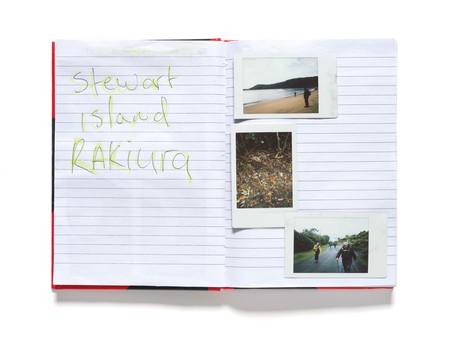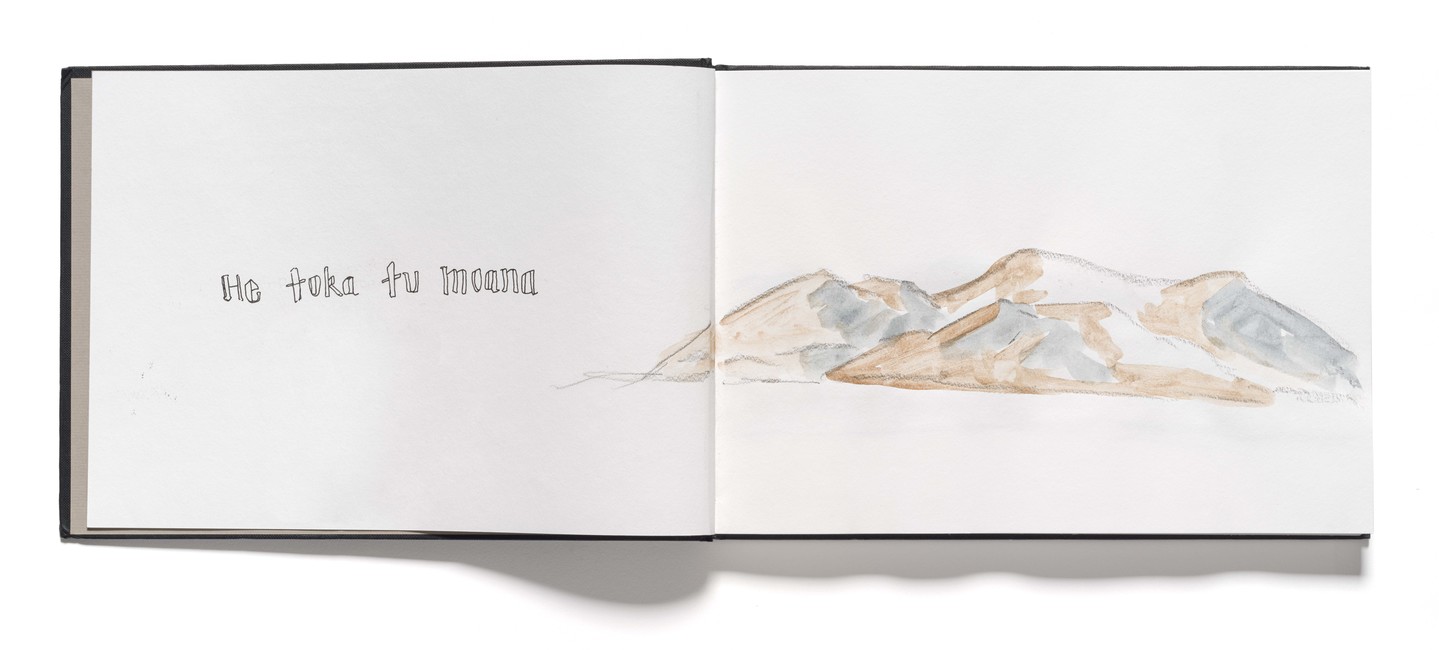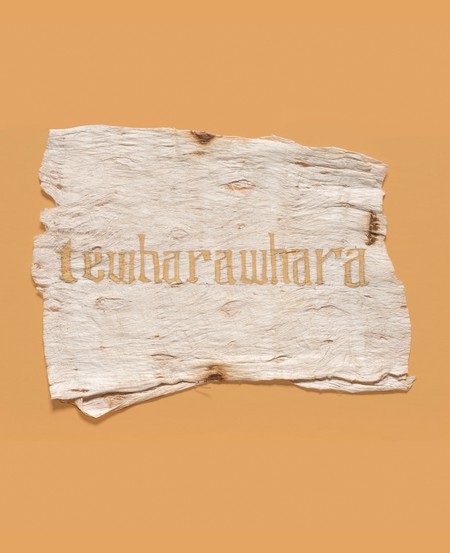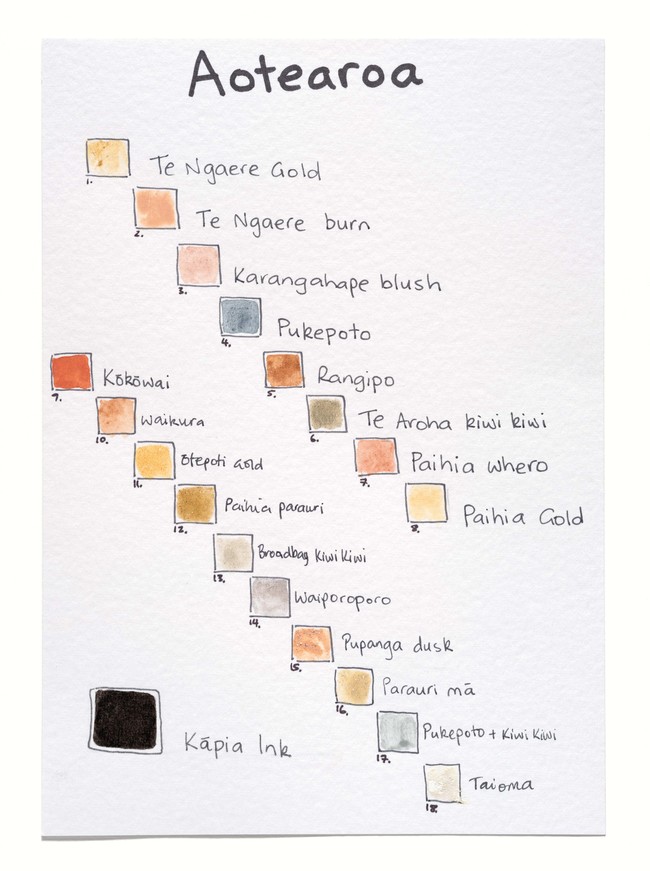Encountering Aotearoa: Whenua, Place and Practice

Cora-Allan Motupohue (Bluff) from the series While at Sea 2023. Whenua, kapia ink, hiapo, brass. Courtesy of the artist
I stand staring at a painting of Motupōhue Bluff Hill. Being from the far south myself, its shape is instantly recognisable, its silhouette painted in vibrant colours that mirror the way light reflects on the real Motupōhue. The paint used to create this familiar scene is made from whenua, and includes pukepoto, the rich blue pigment that comes from the land near the hill: my whenua. There’s a resonance between the work and its materials that makes it special, layered with connections that reflect my own identity and experiences, reaffirming memories and a sense of belonging.

Cora-Allan Encountering Aotearoa 2023. Installation detail, pāpā’s travel journal
Encountering Aotearoa is the outcome of a two-week journey by ship made by artist Cora-Allan (Ngāpuhi, Ngāti Tumutumu, Niue – Liku, Alofi), during which the landscapes and coastlines of Aotearoa New Zealand were viewed, researched and painted from the moana. Cora-Allan was joined on this voyage by her pāpā, and by focusing on sites visited by Cook and the Endeavour in 1769, their experience draws parallels with that of the voyage’s Tahitian navigator Tupaia and his nephew Taiata. Deeper than this, there is a resonance with the way in which our tūpuna, both Māori and of the wider Pacific, once experienced and viewed Aotearoa from waka. For Māori, these experiences still echo today, and make up the foundations of our pepeha. It is through pepeha that we identify our links to waka, mauka, moana and whenua, and these four themes are reflected in Encountering Aotearoa.
Throughout the exhibition there is the sense that the processes, exploration and documentation leading to the creation of the work were shared experiences. The familial relationship between father and daughter is palpable, and demonstrated in diary entries that combine with colourful notes and stickers, detailed yet fun sketches, and archives of carefully documented and creatively named pigments. This is all contextualised by video footage that gives us insight into their relationship and shared journey. The artworks themselves range from the small and intimate – windows onto costal whenua – to large multi-layered pieces that utilise surprisingly vibrant colours obtained from the earth. These give a sense of depth and scale, conveying a feeling of light and warmth. We see cool clouds with swirling winds and wild landscapes painted from the perspective of the ocean, which few of us have the privilege to witness.
While there is a focus on land and coastlines, it is important to recognise that Encountering Aotearoa is more than a gallery of painted landscapes; it is the product of a series of cultural intersections that form the many faces of contemporary Aotearoa. Our unique blend of Pacific, Māori and Pākēha cultures and the combination of our joint experiences enables the creation of work like this. Encountering Aotearoa is reflective of Cora-Allan’s own whakapapa living in Aotearoa as a Pacific person of Niue and Māori descent.

Cora-Allan Ōtautahi (Christchurch) from the series While at Sea 2023. Whenua, kāpia ink, hiapo, brass. Courtesy of the artist

Cora-Allan Manaaki whenua, manaaki tangata, haere whakamua 2023. Whenua, kāpia ink and cyanotype on hiapo. Colour palette: Te Ngaere gold, Te Ngaere burn, Karangahape blush, Te Aroha kiwikiwi, kōkōwai, waikura, Paihia parauri, waiporoporo, parauri mā. Courtesy of the artist
Cora-Allan is very much a multidisciplinary artist, but she is best known for her hiapo practice. As the first practitioner to revitalise this artform in at least two generations this recognition is well earned. Hiapo is proudly featured throughout the exhibition, and to the casual observer it will likely be seen as a blank cloth or canvas for the creation of her works. But it is important to recognise that hiapo is not a canvas. Grown, prepared and beaten from the bark of the paper mulberry tree (Broussonetia papyrifera), this beautiful and unique cloth requires years of careful cultivation, practice and skill to create. These cloths are complete artworks within themselves that carry stories of use and history specific to Niue and its people. Through her creative process, Cora-Allan has carefully ensured her adornment of these hiapo enhances the overall mana of the cloth, adding to its beauty and richness of story. Hiapo brings its own presence to the work along with a strong sense of the Pacific. When combined with a focus on Māori place names it guides us to view Aotearoa, and the exhibition, with a wider regional perspective.

Cora-Allan Sketchbook 2023

Cora-Allan Nō Te Wharawhara ahau 2023. Te Ngaere gold on hiapo. Courtesy of the artist
Just as hiapo is not a canvas, whenua is not simply a source of paint. The use of earth pigments was once widespread among Māori and historically it was used to adorn the body, taoka and artworks, as well as for skincare and medicine. The colours and textures of these pigments varied greatly from place to place – so much so that every region or iwi had its own unique palette and individual shades were given specific names. They were obtained directly from the local environment, and their colours formed a fingerprint of the location; their use a direct representation of the maker and their living relationship with the land. Today the use of whenua as pigment is undergoing a revival, and a wide range of colours, textures and techniques is present throughout the exhibition. Cora- Allan’s gathering and preparation of these pigments is her own way of encountering Aotearoa – an expression of her Māori heritage in which her identity as takata whenua is articulated through the tangible exploration of the whenua.
Where introduced practices also feature, they add depth to Encountering Aotearoa, most notably the inclusion of Prussian blue cyanotypes that cleverly capture imprints of flora on hiapo. The memory of a wider environmental experience is shared through the outlines of these native plants, giving a sense of exploration reminiscent of the collecting of botanical specimens prevalent among early European explorers. However, unlike early botanists such as Joseph Banks and Daniel Solander, Cora-Allan did not take physical specimens or remove plants from their place of origin. This leaves the art culturally balanced, and her cyanotypes capture the mauri of local flora but do not feel exploitative.

Cora-Allan Whenua Pigments 2023
Within the artworks there are other symbols that connect to Cora-Allan’s previous practice and research. Depictions of taoka from museum collections have been included, such as a rat trap and a kiore, reflecting environmental changes and a previous way of life. The inclusion of painted Cuisenaire rods, commonly used in the classroom, hints at the learning and reclamation of te reo Māori. A painted poutama pattern suggests the contemplation of whakapapa and the pursuit of knowledge. Together these act as a series of storyboards, giving the viewer insight into the artist’s journey while providing a sense of connection to the past.
At its heart, Encountering Aotearoa is a story about our relationship to whenua. For some people this exhibition will generate thoughts of the Endeavour and the experiences of those on board as they saw the coastlines of Aotearoa for the first time. For others it is the opportunity to see home through an Indigenous lens, using hiapo and whenua. While there are many ways to encounter place, Cora-Allan’s Māori and Niue heritage contextualises Aotearoa and reaffirms our place in the wider Pacific. Through cultural practice and contemporary art she shares her journey and invites us to contemplate how we all encounter Aotearoa.
Hiapo – bark cloth from Niue
Kiore – Polynesian rat
Mauka – mountain
Mauri – life-force
Moana – ocean
Pepeha – tribal saying
Poutama – stepped pattern symbolising genealogies and also the various levels of learning
Taoka – treasure
Takata whenua – Indigenous people, literally meaning people of the land
Tūpuna – ancestors
Waka – canoe
Whakapapa – genealogy
Whenua – land, ground, earth








